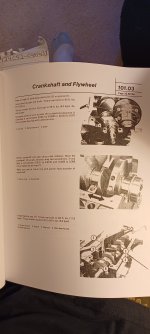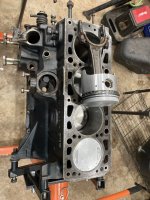Re:- Broken stud removal.
I'm a great believer of using penetrating fluid (you choice) and giving it plenty of time to work.
I'd position the cyl. head with the broken stud vertically, remove the stud and apply penetrating oil. I might gently heat the head surrounding the broken stud and then apply the penetrating oil, the sudden cooling may draw in the penetrating fluid better.
Chances are that the broken portion of the stud is bottomed out in the threaded hole.
It's important to start drilling at the exact centre of the stud - if below the surface, given that the cyl. head is al. alloy, I might try refitting the exhaust manifold to try to guide the drill bit. Or I might drill a hole is a piece of steel plate, align this hole with the exact centre of the broken stud, clamp the plate to the cyl. head and use it as a guide for drilling the stud centre.
There are stud extractor sets that include guide bushes for the drilling process. I prefer to use a spline type of extractor rather than the tapered screw type. E.g. :-


In my early days (with very few tools and even less money) I used to drill 2 holes, a small one the full of the broken piece of stud and a larger hole halfway in, then tap the tapered square tang of a file in and use this to wind out the broken stud - if done gently, this often worked but if the tang of the file broke off in the broken, stuck, stud...
An even easier way of removing studs broken off below the surface is not to use any penetrating oil, just use an arc welder to stick a flux-coated rod to the broken stud, disconnect the rod holder, allow the heat to spread into the head and then try using the welding rod to wind the stud out.
This is also how a broken head bolt can be removed in situ without having to remove the cylinder head...
And if a cyl. head bolt were to break, the broken threaded piece (the fracture point will usually occur in the threads that were not engaged with the threads in the cyl. block) will not be tight so should be easy to unscrew and remove. So, no big deal.
I'm a great believer of using penetrating fluid (you choice) and giving it plenty of time to work.
I'd position the cyl. head with the broken stud vertically, remove the stud and apply penetrating oil. I might gently heat the head surrounding the broken stud and then apply the penetrating oil, the sudden cooling may draw in the penetrating fluid better.
Chances are that the broken portion of the stud is bottomed out in the threaded hole.
It's important to start drilling at the exact centre of the stud - if below the surface, given that the cyl. head is al. alloy, I might try refitting the exhaust manifold to try to guide the drill bit. Or I might drill a hole is a piece of steel plate, align this hole with the exact centre of the broken stud, clamp the plate to the cyl. head and use it as a guide for drilling the stud centre.
There are stud extractor sets that include guide bushes for the drilling process. I prefer to use a spline type of extractor rather than the tapered screw type. E.g. :-
In my early days (with very few tools and even less money) I used to drill 2 holes, a small one the full of the broken piece of stud and a larger hole halfway in, then tap the tapered square tang of a file in and use this to wind out the broken stud - if done gently, this often worked but if the tang of the file broke off in the broken, stuck, stud...
An even easier way of removing studs broken off below the surface is not to use any penetrating oil, just use an arc welder to stick a flux-coated rod to the broken stud, disconnect the rod holder, allow the heat to spread into the head and then try using the welding rod to wind the stud out.
This is also how a broken head bolt can be removed in situ without having to remove the cylinder head...
And if a cyl. head bolt were to break, the broken threaded piece (the fracture point will usually occur in the threads that were not engaged with the threads in the cyl. block) will not be tight so should be easy to unscrew and remove. So, no big deal.
Last edited:



